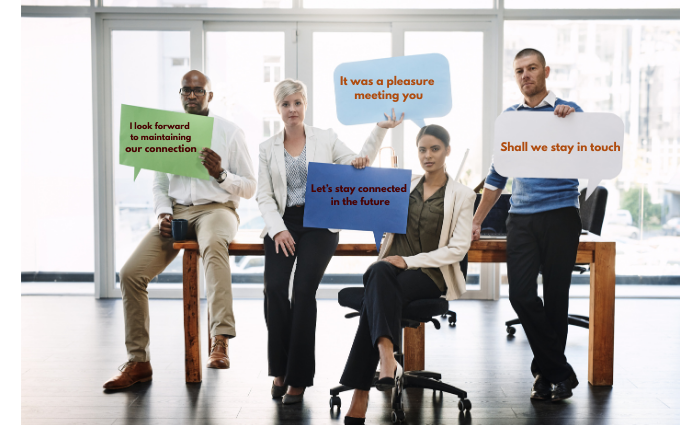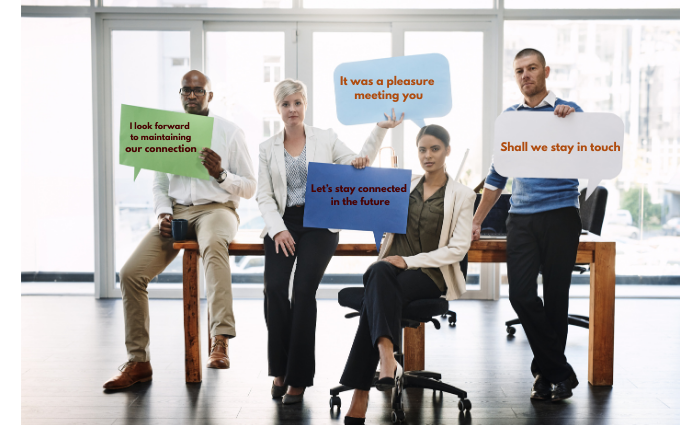
Introduction
“Stop saying ‘let’s keep in touch.’ Discover formal alternatives that sound confident, genuine, and help you build lasting professional connections.”
Why “Let’s Keep in Touch” Matters in Professional Communication
When it comes to business, words matter. The phrase “let’s keep in touch” sounds polite, but it’s often too casual. In professional communication, the way you close a conversation can open doors, or quietly close them.
Networking and Career Growth
Strong careers are built on strong connections. Networking isn’t just about meeting people; it’s about staying connected. A formal way to say “let’s keep in touch” shows that you respect the relationship and value future opportunities.
The Power of Closing Remarks
Your last words are like a final handshake. People may forget your small talk, but they remember how you end. A confident closing, whether in an email, interview, or meeting, can leave a lasting impression.
Avoiding Generic or Insincere Phrases
Here’s the problem: “let’s keep in touch” is vague and overused. It can feel empty, like you don’t really mean it. Using formal alternatives such as “I look forward to ongoing correspondence” or “shall we stay in touch?” makes your message clear, personal, and professional.
The Best Formal Alternatives to “Let’s Keep in Touch”
Not every situation calls for the same closing line. If you want to sound polished and leave the right impression, you need the right words for the right moment. Here are some formal alternatives to “let’s keep in touch” that work in different professional settings.
Highly Professional Options
In corporate emails, networking events, or client meetings, you need phrases that show respect and professionalism. Instead of the usual line, you could say, “Shall we stay in touch?” which is polite and gives the other person a choice. If you want to sound warmer, “I look forward to maintaining our connection” shows that you value a long-term relationship. For situations that require clarity, such as ongoing projects, “I propose we stay in regular communication” works best. And when you are writing to a senior leader or important client, “I suggest we maintain professional correspondence” is a polished way to close.
Polite but Slightly Less Formal Options
Sometimes you don’t need to be overly formal. With colleagues or business acquaintances, lighter phrases work better. You might say, “Let’s stay connected in the future” or “Let’s keep the lines of communication open.” Both are friendly but professional. A shorter option like “Keep me updated” also works well, while “I look forward to ongoing correspondence” keeps things respectful without being stiff.
Short and Clear Alternatives
There are also moments when quick closings are enough. Instead of sounding vague, you could simply say, “Stay in touch with me,” “Let’s not lose touch,” or “Let’s stay in contact.” Even a more polished phrase like “Let’s uphold our communication channels” works when you want to keep things professional but simple.
How to Choose the Right Expression

Knowing different ways to say “let’s keep in touch” is useful, but the real skill is knowing which one to use. Not every phrase fits every situation. The right choice depends on the context, the people involved, and even the culture you’re speaking in.
In formal meetings, job interviews, or networking events, polished language is best. A phrase like “I look forward to maintaining our connection” shows respect and professionalism. In a friendly business chat, however, that might sound too stiff. Something lighter, like “Let’s stay connected in the future,” works better. The tone should always match the setting.
It also matters who you are speaking to. Talking to a manager, a senior leader, or a potential client requires a more formal closing. On the other hand, when you’re speaking to a peer or teammate, you can keep things simple and warm. Choosing the right level of formality shows emotional intelligence and helps avoid awkwardness.
Culture and industry also play a role. What sounds polite in one workplace might feel too formal in another. For example, tech startups often use more casual closings, while law firms may expect more polished language. Pay attention to the norms around you and adapt.
Finally, sincerity matters most. People can tell when you don’t really mean what you say. Even the best phrase falls flat if it sounds forced. Whatever words you choose, make sure they reflect genuine interest in staying connected. That’s what leaves a lasting impression.
Examples of Usage in Professional Scenarios

Learning formal ways to say “let’s keep in touch” is one thing. Knowing how to use them in real life is another. The good news is that these phrases can fit smoothly into different professional settings. With the right closing line, you can leave a strong and lasting impression.
Take email, for example. Instead of ending with the plain “let’s keep in touch,” you might write, “I look forward to maintaining our connection as we explore future opportunities.” This shows you’re not just being polite, you’re interested in a long-term relationship. It feels thoughtful and professional, which makes your message stand out in someone’s inbox.
At networking events, the setting is more personal but still professional. After a great conversation, you could say, “It was a pleasure meeting you. Shall we stay in touch?” This approach is warm, respectful, and invites the other person to agree. It makes it clear you value the connection and want to continue it beyond the event.
When it comes to client relations, the goal is to build trust and keep the door open for future work. A strong closing line could be, “Let’s ensure our lines of communication stay open for future collaborations.” This tells the client you’re committed to staying connected and ready for new opportunities. It feels reliable and professional, which is exactly what clients want.
In each of these situations, the right words can strengthen your relationships. By choosing clear, formal alternatives to “let’s keep in touch,” you not only sound more confident but also show that you truly value the connection.
Common Mistakes to Avoid
Even with plenty of formal ways to say “let’s keep in touch,” it’s easy to slip into habits that weaken your message. The right phrase can build trust, but the wrong approach can make you sound careless or insincere. Here are some common mistakes to watch out for.
One big mistake is using overly casual language in a professional setting. Saying something like “Catch you later” or “Hit me up sometime” may work with friends, but it doesn’t fit in a business email or client meeting. Casual phrasing can make you look unprofessional, and it may leave the other person unsure about how serious you are. A formal alternative sends the right signal.
Another mistake is sounding robotic or forced. If you copy and paste the same closing line into every email, people will notice. Phrases like “I suggest we maintain professional correspondence” are strong, but they must feel natural. If your words don’t match your tone or your relationship with the other person, they can come across as stiff or fake. The goal is to sound polished, not mechanical.
The last mistake is using the same phrase for every situation. Communication is not one-size-fits-all. A line that works in a job interview may feel too formal when speaking with a colleague. Personalization is key. Adjust your closing to the person, the setting, and the purpose of the conversation. Doing this shows emotional intelligence and makes your message more memorable.
By avoiding these mistakes, your words will feel more natural, sincere, and professional. And that’s how you turn a simple closing line into a lasting connection.
Conclusion
The words you choose can shape how others see you. Even a simple closing line matters. While “let’s keep in touch” feels polite, it often sounds vague or insincere. That’s why learning formal ways to say let’s keep in touch is so powerful. These alternatives show professionalism, sincerity, and respect, qualities that leave a lasting impression. Remember, small details can set you apart in emails, meetings, or networking events. Choose the phrase that matches your tone, audience, and context. Start practicing today, and watch your professional connections grow stronger and more meaningful.







